#Kannada district
Text
*Logs onto twitter* *Reads the replies of one tweet* *logs off twitter*
#I complain about tumblr a lot but Twitter truly is a cesspool#was reading an interesting thread about a practice in dakshina Kannada district#it involves marrying two spirits of children who have passed away 30 years after they were born#clearly a tradition that emerged in order to make peace with the grief of losing a child#half the replies were Americans going ‘ooooh wooow so scaryy’ or ‘this is primitive custom is clearly all pretend I am very intelligent’#literally shut uppp Twitter people are so brain dead#tara talks
2 notes
·
View notes
Photo

#Mauganj was declared as 53rd district of Madhya Pradesh by Shivraj Singh Chouhan, the chief minister of Madhya Pradesh. Mauganj is a tehsil of the Rewa district. CM Chouhan declared that Mauganj would become the 53rd MP district during a function in #Rewa . It will be built by combining four of the Rewa district’s tehsils. ಮೌಗಂಜ್ ಅನ್ನು ಮಧ್ಯಪ್ರದೇಶದ 53 ನೇ ಜಿಲ್ಲೆ ಎಂದು ಮಧ್ಯಪ್ರದೇಶದ ಮುಖ್ಯಮಂತ್ರಿ ಶಿವರಾಜ್ ಸಿಂಗ್ ಚೌಹಾಣ್ ಘೋಷಿಸಿದರು. ಮೌಗಂಜ್ ರೇವಾ ಜಿಲ್ಲೆಯ ತಹಸಿಲ್ ಆಗಿದೆ. . FALLOW US 👇 @current_affairs_in_kannada ನಮ್ಮ PAGE ಅನ್ನು FOLLOW ಮಾಡಿ POST & STORY NOTIFICATION 🔔 on ಮಾಡಿಕೊಳ್ಳಿ #currentaffairskannada #currentaffairsinkannada #generalknowledgeinkannada #caik #news #currentaffairs #kannada #dailyupdates #kpsc #kptcl #upsc #up #uttarpradesh #uptourism #districts s (at Mauganj Upcoming District of Madhyapradesh) https://www.instagram.com/p/CphEz7gvJft/?igshid=NGJjMDIxMWI=
#mauganj#rewa#currentaffairskannada#currentaffairsinkannada#generalknowledgeinkannada#caik#news#currentaffairs#kannada#dailyupdates#kpsc#kptcl#upsc#up#uttarpradesh#uptourism#districts
0 notes
Video
youtube
Jamboo Savari 2022 || Somana Kunitha || Folk Dance Of Karnataka Mysuru...
#youtube#Worship Of Mother Goddess#Performed By Gangemate Community#Gaurdian Spirit Dance#Somana Kunitha#Mask Dance#Somas#South Kannada District#Jamboo Savari 2022#Mysuru Dasara @022#Folk Dances Of Karnataka
0 notes
Text
ಬಾಗಲಕೋಟೆ: ಕೆರೂರಿನಲ್ಲಿ ಎರಡು ಗುಂಪುಗಳು ಪರಸ್ಪರ ಹೊಡೆದಾಟ, ಘರ್ಷಣೆ, ಉದ್ವಿಗ್ನ ವಾತಾವರಣ, ಶಾಲೆಗಳಿಗೆ ರಜೆ
ಬಾಗಲಕೋಟೆ: ಕೆರೂರಿನಲ್ಲಿ ಎರಡು ಗುಂಪುಗಳು ಪರಸ್ಪರ ಹೊಡೆದಾಟ, ಘರ್ಷಣೆ, ಉದ್ವಿಗ್ನ ವಾತಾವರಣ, ಶಾಲೆಗಳಿಗೆ ರಜೆ
ಬಾಗಲಕೋಟೆ: ಬಾದಾಮಿ ತಾಲ್ಲೂಕಿನ ಕೆರೂರು ಪಟ್ಟಣದಲ್ಲಿ (Keruru) ಉದ್ವಿಗ್ನ ವಾತಾವರಣ (Communal Violence) ನೆಲೆಸಿರುವ ಹಿನ್ನೆಲೆಯಲ್ಲಿ ನಾಳೆ (ಜುಲೈ 8) ರಾತ್ರಿ 8 ಗಂಟೆಯವರೆಗೂ 144ನೇ ವಿಧಿಯ ಅನ್ವಯ ನಿಷೇಧಾಜ್ಞೆ ಜಾರಿಗೊಳಿಸಿ ಜಿಲ್ಲಾಧಿಕಾರಿ ಪಿ.ಸುನಿಲ್ ಕುಮಾರ್ ಆದೇಶ ಹೊರಡಿಸಿದ್ದಾರೆ. ಪಟ್ಟಣದ ಎಲ್ಲ ಶಾಲಾ-ಕಾಲೇಜುಗಳಿಗೂ ರಜೆ ಘೋಷಿಸಲಾಗಿದೆ. ನಿನ್ನೆ ರಾತ್ರಿ (ಜುಲೈ 6) ಎರಡು ಗುಂಪುಗಳು ಪರಸ್ಪರ ಹೊಡೆದಾಟಕ್ಕೆ ಇಳಿದವು. ಗುಂಪು ಘರ್ಷಣೆಯಲ್ಲಿ ಒಟ್ಟು ನಾಲ್ವರು ಗಾಯಗೊಂಡಿದ್ದಾರೆ.…
View On WordPress
0 notes
Text
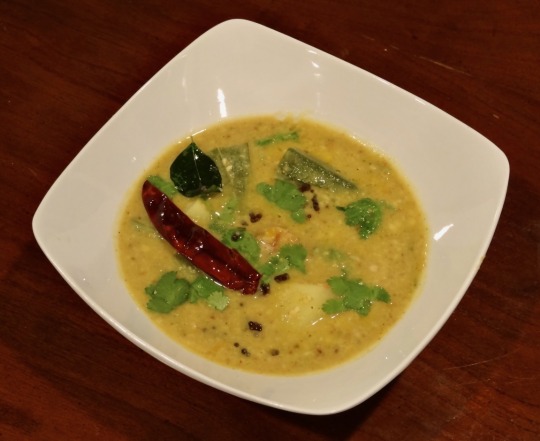
[ID: A bowl of a bright yellow stew topped with cilantro, mustard seed, chili, and curry leaf. End ID]
ಉಡುಪಿ ಸಾಂಬಾರ್ / Udupi sambar
A sambar is a lentil-and-vegetable stew distinguished by the use of a particular spice blend (Hindi: सांबर मसाला "sāmbār masālā," "sambar spice"; Kannada: ಸಾಂಬಾರ್ ಪುಡಿ "sāmbār puḍi," "sambar powder"). Sambars are a staple of South Indian and Sri Lankan cooking, sometimes made in households for multiple meals a week. The word "sambar" can be traced back to the Sanskrit सम्भार "sambhārá," "collection of things required for a particular purpose”; “spices."
The lentil used in sambar dishes is usually tur dal (split pigeon peas), though arhar dal, tuvur dal, or even blends containing masur or mung dal may be used, depending on the cook or the region. Vegetables also vary between combinations of okra, potato, ash gourd (petha), bottle gourd (doodhi / lauki), drumstick (saijan ki phalli), beetroot, tomato, carrot, pumpkin, brinjal, and pearl onions, among others. The sambar masala fries chilis, curry leaves, dal, and various spices including cumin, coriander, and fenugreek, then grinds them into a spicy, earthy, fragrant blend.
This recipe makes a sambar in the style of ಉಡುಪಿ (Udupi) cuisine—a subdivision of the cuisine of the ತುಳುವ (Tuluva) people localised in the Udupi District of Karnataka, a southeastern coastal state of India. (Tuluva cuisine is also commonly found in Dakshina Kannada, Karnataka, and Kasaragod, Kerala). In the Udupi region, sambar may be known as "ಕೊಡೆಲ್" "kodhel"; perhaps related to "ಕಡಲೆ" "kadhale" "Bengal gram"; or "ಹುಲಿ" "huḷi"; "tartness." Udupi huli has coconut oil and jaggery as its primary distinguishing features: the jaggery's deep sweetness and the earthy pungency of unrefined coconut oil combine with the spice of the chilis and the sour fruitiness of the tamarind to create a complex, flavorful, well-balanced dish.
Udupi huli may be further divided into a few major types. ಮಸಾಲೆ ಹುಳಿ ("masāla huḷi") contains shredded coconut and vegetables; ಬೋಳು ಹುಳಿ ("bolu huḷi") contains vegetables, but omits the coconut.
Hotel-style masala huli recipes typically add a lot of jaggery to produce a distinct sweetness; cut back on the amount of coconut included; and contain onion and garlic. The other main type of masala huli—“temple style”—is sattvic (from Sanskrit "सत्त्व" "sattva": "goodness," "essence," "existence"), which in this context means that onions and garlic are excluded.
A sattvic diet in Hinduism centres around the concept of maintaining sattva by eating only pure and mild (sattvic) foods, and omitting tamasic (“dark,” "inert," "destructive"; from Sanskrit तमस् "tamas") and rajasic ("exciting," "passionate," from Sanskrit रजस् "rajas") ones. The concepts of sattva, tamas, and rajas (the गुण "guṇa" system) are central to the construction of caste: the degree to which each person innately inherits each quality supposedly determines their possession of characteristics including honesty, intelligence, and goodness (sattva), stupidity and lack of creativity (tamas), and passion and pridefulness (rajas); the possession of these characteristics in turn determines their rightful place in a professional and social hierarchy. The association of certain foods with certain qualities thus links diet to caste: a distinction in diet is one of the methods by which those belonging to upper castes maintain and police caste boundaries.
This recipe makes enough pudi for one pot of sambar. Traditionally, sambar pudi is created fresh each time the dish is made, but many households make large batches and store them. In this case, omit the coconut; or, use dried coconut and store the masala in the refrigerator.
Recipe under the cut!
Patreon | Paypal | Venmo
Ingredients:
Serves 4-6.
For the sambar:
2 cups chopped vegetables
1 red onion, sliced*
1 cup (200g) yellow split pigeon peas / tur dal / ತೂರ್ ದಾಲ್ (ಹಳದಿ ಸ್ಪ್ಲಿಟ್ ಪಾರಿವಾಳದ ಬಟಾಣಿ)
4 cups (1 litre) water, or as needed
1/4 tsp ground turmeric / haldi / ಅರಿಶಿನ
2 tsp table salt
2 tsp jaggery / gur / ಬೆಲ್ಲ*
1/4 cup (60mL) tamarind pulp (from 1 Tbsp dried tamarind / imlie / ಹುಣಸೆಹಣ್ಣು)
2 tsp unrefined coconut oil / nariyal ka tel / ತೆಂಗಿನ ಎಣ್ಣೆ
Ingredient list format is English / Hindi (Latin transcription) / Kannada. The Hindi is provided for convenience while shopping.
Udupi sambar usually uses any of: gourd, brinjal (Indian eggplant), pumpkin, dumstick (saijan ki phalli), and okra. Pearl onion is not usually used in this region, but you can add whatever you want, according to taste.
*For a hotel-style sambar, include the onion; increase the jaggery to 2 Tbsp.
For the spice paste / sambar masala / ಸಾಂಬಾರ್ ಪುಡಿ ("sambar pudi"):
1/2 Tbsp split Bengal gram / chana dal / ಹಳದಿ ಸ್ಪ್ಲಿಟ್ ಗ್ರಾಂ
2 tsp split black gram / urad dal chilka / ಸ್ಪ್ಲಿಟ್ ಬ್ಲ್ಯಾಕ್ ಗ್ರಾಂ
2 tsp coriander seeds / dhaniya / ಕೊತ್ತಂಬರಿ ಬೀಜದ
1/2 tsp fenugreek seeds / methi / ಮೆಂತ್ಯ
1 tsp cumin seeds / jeera / ಜೀರಿಗೆ
1 tsp ground turmeric
5-6 curry leaves / kari pati / ಕರಿಬೇವು
3-4 Byadagi or other dried red chilis / byadagi mirch / ಬ್ಯಾಡಗಿ ಮೆಣಸಿನಕಾಯಿ
4 cloves garlic, skins on*
Large pinch asafoetida / hing / ಇಂಗು
1 cup (100g) fresh coconut (about one coconut)*
1/2 cup (120mL) water
While the ratio of ingredients in Udupi sambar pudi vary slightly, the ingredients themselves are almost always consistent.
*For a hotel-style sambar, include the garlic, and decrease the coconut in the sambar masala to 1/4 or 1/2 cup (25-50g).
The grams and pulses in this pudi have many different names. You can find them in a halal or South Asian grocery store; look on the bag for the Hindi names (since they have been transcribed into Latin, the spelling may vary from what you see here).
The urad dal you find may be husked, and thus yellow instead of black; these will work just as well.
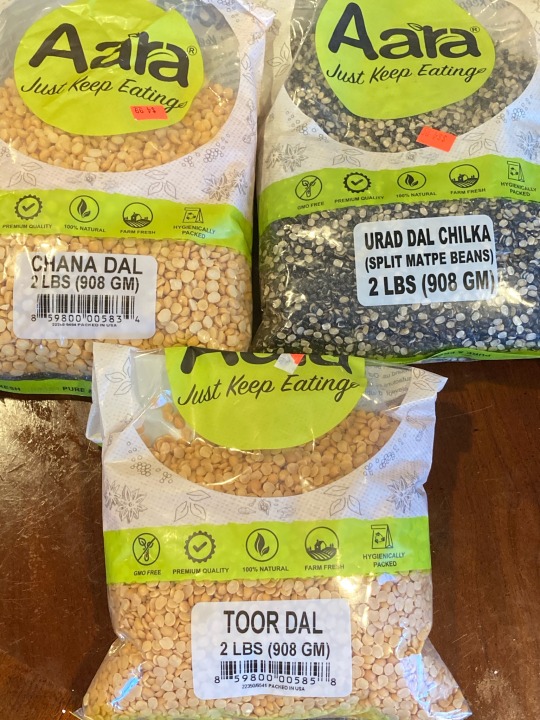
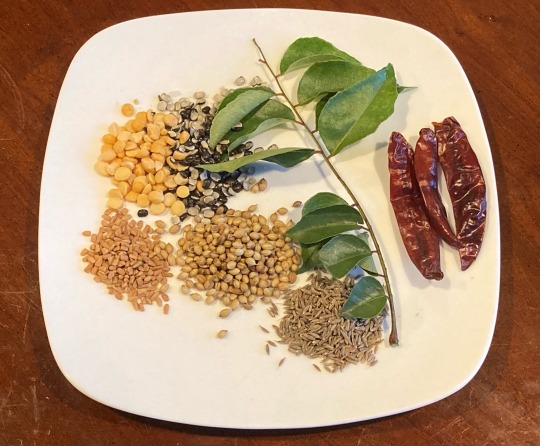
For the tempering / tadka / ಹದಗೊಳಿಸುವ:
2 Tbsp unrefined coconut oil
2 red chilis
8 curry leaves
1 tsp brown mustard seeds / rai / ಸಾಸಿವೆ ಬೀಜಗಳು
Recipes from north Karnataka may add cumin and whole, unpeeled garlic cloves to the tempering.
Instructions:
For the sambar pudi:
1. Break open the coconut and remove and shread its flesh.
If using a whole dried coconut, break into the shell with the wrong side of a hammer and pry open. Break into a few smaller pieces and peel with a vegetable peeler until the skin is removed from the white flesh, wearing something to protect your hand. Soak in warm water for several minutes to soften, and then grate or food process.

2. Heat 2 Tbsp of coconut oil in a skillet on medium-low. Add asafoetida and fry for 30 seconds, until no longer raw-smelling. Add dal and fry, stirring often, for 30 seconds until golden brown; add coriander, mustard, fenugreek, and cumin seeds and fry until fragrant.
3. Add curry leaves and fry until wilted, then add garlic and dried chilis and fry another 30 seconds to a minute, until fragrant.
4. Add coconut and fry, stirring often, for another few minutes until a shade darker. Add turmeric and stir.
5. Grind all ingredients into a paste in a mortar and pestle, then mix in about 1/2 cup water to loosen (if using dried coconut, you may need more water).
Or, put all ingredients along with 1/2 cup water into a blender or food processor and process until a relatively smooth paste forms.
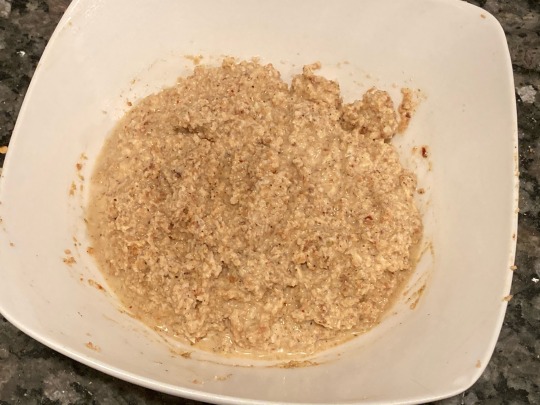
For the sambar:
1. Wash tur dal to remove excess starch. Simmer dal with 2 cups water, 1/4 tsp ground turmeric, and 1 tsp coconut oil for about 30 minutes until very tender. Mash until relatively smooth with a wooden spoon or bean masher, or process briefly with an immersion blender.
You may soak the dal in water after rinsing them to reduce the cooking time, but it is not necessary.
2. Meanwhile, make the tamarind paste. Soak 1 Tbsp tamarind dried pulp in 1/4 cup hot water for 20-30 minutes. Squeeze the tamarind into the water to extract the pulp. Discard the tamarind seeds and husk. Optionally, depending on your preferred texture, push the mixture through a metal sieve.
3. Prepare vegetables. Slice the onion; remove ends of okra and drumsticks and cut into 2-inch pieces; quarter tomatoes; quarter brinjal; peel pumpkin and cut into cubes; peel and cube potatoes.
4. If using onion, add a teaspoon of coconut oil to a large pot and fry until translucent.
5. In the same pot, boil vegetables in just enough water to cover, along with a pinch of salt, until they are beginning to soften.
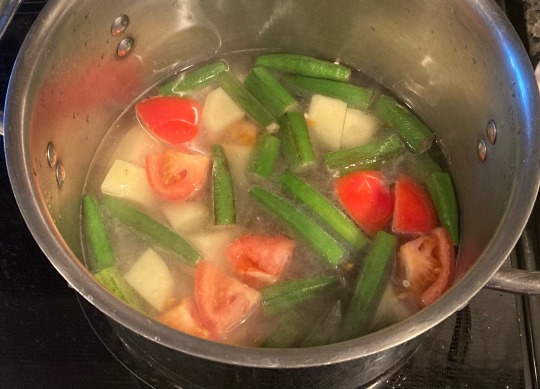
Some recipes call for the vegetables to be boiled, and others call for them to be steamed. I prefer boiling, since it produces a nice savory broth.
6. Mix vegetables, dal, tamarind, jaggery, sambar pudi, and salt to taste and simmer 5-10 minutes to allow flavors to combine and vegetables to cook under tender. Add water as needed. Remove from heat and stir in cilantro. Taste and adjust salt.
The final sambar should be pourable, like a thick soup—Karnataka sambar is typically thinner in consistency than Tamil Nadu versions.
For the tadka:
1. Heat coconut oil in a small skillet on medium heat. Add tempering ingredients and fry, stirring often, until chilis and curry leaves are a couple shades darker and the mixture is fragrant.
2. Pour the oil and tempering ingredients into the sambar and stir in. If you like, retain some of the tadka as a garnish to serve.
3. Serve warm, in individual bowls, alongside long-grain white rice. To eat drumsticks, scoop the center out and eat it; the tough outer rind is left.
If you intend to save some sambar, it's a good idea to make just enough tadka for what you plan to eat that day, and then make fresh tadka to pour over the reheated leftovers.
106 notes
·
View notes
Text

A new genus and new species of freshwater crab (Decapoda: Brachyura: Gecarcinucidae) from the Central Western Ghats of India
SAMEER KUMAR PATI+ PARASHURAM PRABHU BAJANTRI+ GOPALKRISHNA DATTATRAYA HEGDE
Abstract
A new genus and new species of gecarcinucid freshwater crab, Aradhya placida gen. et sp. nov., is recognized from the northern part of the Central Western Ghats of India.
The new genus is diagnosed, and the new species from the Uttara Kannada district of Karnataka state, is described herein.
The new genus most resembles Arcithelphusa Pati & Sudha Devi, 2015, Cylindrotelphusa Alcock, 1909, Rajathelphusa Raj, Kumar & Ng, 2021, and Pavizham Raj, Kumar & Ng, 2022, in having an ovate, relatively narrow and deep carapace, with the front narrow as compared to other Indian gecarcinucid genera.
Aradhya gen. nov. is nevertheless separated from those genera by the characters in the carapace, epigastric and postorbital cristae, external orbital angle, cervical grooves, third maxilliped, chelipeds, male thoracic sternites/sternopleonal cavity/pleon, male second gonopod, and especially by the elongated male telson and the stouter ultimate article of the male first gonopod.
Read the paper here:
A new genus and new species of freshwater crab (Decapoda: Brachyura:Gecarcinucidae) from the Central Western Ghats of India | Zootaxa (mapress.com)
65 notes
·
View notes
Text

Sharavathi Railway Bridge, Honnavara Uttara Kannada, Tamilnadu India: Sharavathi Railway Bridge is a marvel that spans the Sharavati River, carrying the Konkan Railway. Honnavar is a town in Uttara Kannada district of Karnataka, India. Wikipedia
33 notes
·
View notes
Text
Bantwal
Bantwal is a Taluk of Mangalore in Dakshina Kannada district, Karnataka, India, and the headquarters of Bantwal taluk. It is located 25 km (16 mi) East of Mangalore city center. BC Road-Kaikamba of Bantwal is one of the fastest developing areas in Dakshina Kannada district of Karnataka.
Along with BC Road-Kaikamba, Panemangalore & Melkar regions are also urbanized. They are also developing as the eastern suburbs of Mangalore. Towards east of Mangalore, the stretch to BC Road-Kaikamba region forms a continuous Mangalore Urban Agglomeration area which is currently the second biggest in Karnataka after Bangalore. Bantwal is the fourth largest urban area in Dakshina Kannada district after Mangalore, Ullal (both comes under Mangalore Urban Agglomeration area) & Puttur in terms of population.
It is situated on the banks of River Nethravati on the National Highway 73 (India). The adjacent town of B.C. Road (Bantwal Cross Road) serves as the commercial center.
Previously, the town of Bantwal was known for trade with the Persian Gulf states, being so close to Mangalore. However, flooding caused by the river Netravathi during the monsoons compelled traders and newer settlements to move to the adjacent city of B.C. Road due to its higher altitude. Gradually, most Government offices shifted to B.C. Road.
Top sights in Bantwal




Adyar Falls
Prior to 1852, Bantwal Taluk was the largest taluk in the entire of Canara Province (then comprising North Canara, Udupi, Mangalore and Kasaragod Districts) with 411 villages and a total population of 1,69,416. In 1852, a portion of it was formed into the Taluk of Puttur.[2] Bantwal was an entrepot for the produce of the province on its way to the Mysore Country and had derived a great benefit of late years from the extension of the coffee trade. It contained about thousand scattered houses inhabited by Billava, Bunts, Bhandary, Ganigas, Kulals, Goud Saraswat Brahmins, Konkani Catholics and a few Jains.[2]
Bantwal is located along the coast of river Netravathi. Every year due to heavy rains the river floods. National Highway 73 cuts through B. C. Road. The highway serves as the conduit for several arterial routes leading to neighbouring towns with Mangalore. Mangalore is connected with other cities in Karnataka such as Mysore and Bangalore by National Highway 275 (India) and National Highway 75 (India) respectively. It is well connected to Uppala through Uppala-Mudipu-Bantwal Highway.
3 notes
·
View notes
Photo

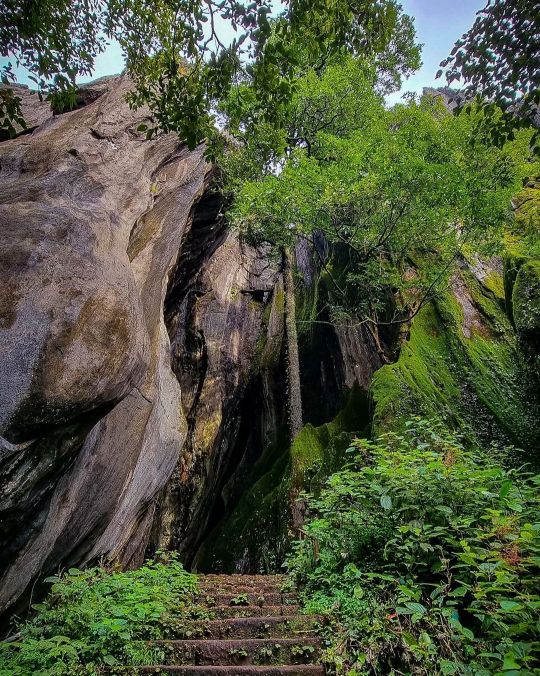

Yana Rock in Uttara Kannada, Karnataka
Vijay wrote :
Yana - The limestone monolith The gigantic crystalline - like rock formations of Yana stand proud and tall among the evergreen forests of the Western Ghats in Uttara Kannada District.
(via Instagram: Vijay @vij.eye)
39 notes
·
View notes
Quote
Pre-poll surveys, exit polls, and analyses of election results emerging from Karnataka have all made it apparent that the highest preference for the right-leaning BJP – which, at least symbolically, frowns upon freebies – was shown by the wealthiest and most educated segment. Preference for the left-leaning Congress and JD(S) – which campaigned on the plank of welfare schemes – increase as we proceed to the poorer and less educated segments. Three of the four districts in Karnataka where the BJP managed to win a majority of the Assembly seats are Bengaluru Urban (16/28), Dakshina Kannada (6/8), and Udupi (5/5), districts that constantly top the Human Development Index and per-capita income rankings in the state, statistics that indicate a higher concentration of the rich. Everywhere else, the Congress and the JD-S won a majority of the seats. This dissonance in the voting pattern can be attributed, at least in part, to the increasing inequality between the rich and the rest, in Karnataka and across India.
Rakshith Ponnathpur, ‘The rich, the rest and freebies: Unpacking a problematic narrative’, Deccan Herald
#Deccan Herald#Rakshith Ponnathpur#2023 Karnataka Assembly elections#Karnataka#BJP#INC#JD(S)#Bengaluru Urban#Dakshina Kannada#Udupi#Human Development Index#per-capita income#voting pattern#inequality#India
5 notes
·
View notes
Text
Kantara
Kantara -A rare piece of cinematic brilliance from KFI. Hats off Rishab Shetty!
‘Kantara’ is a Kannada movie written and directed by Rishab Shetty. He also stars as the main protagonist along with Achyuth Kumar, Kishore and Sapthami in key supporting roles.
Introduction
The movie traces a mythical legend from 1847 set in Dakshina Kannada region (Udupi and Kasargod districts). A King is travelling in his territory looking for peace and happiness. He meets with Panjurli…

View On WordPress
#AchyuthKumar#ApsaraAali#Art#Artist#DakshinaKannada#HumanNatureConflict#Kantara#Kishore#Legend#Myth#Navarasam#RishabShetty#SingaraSiriye#Tribals#VarahaRoopam
7 notes
·
View notes
Text
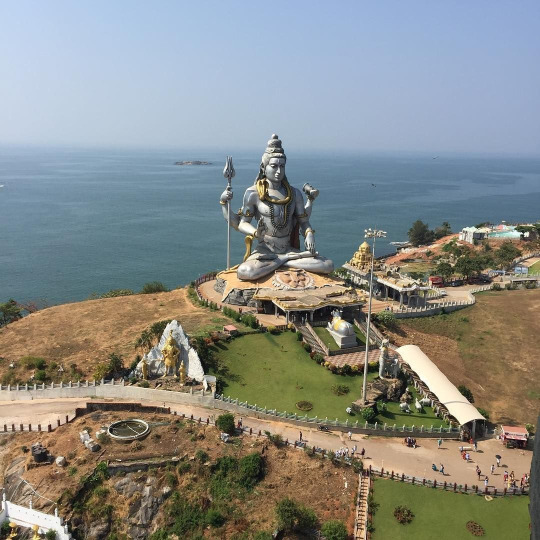
Murdeshwar is a town in Bhatkal Taluk of Uttara Kannada district in the state of Karnataka, India.
A huge towering statue of Shiva,123 feet (37 m) tall graces the temple complex.
2 notes
·
View notes
Text
"Embracing Eco-Friendly Dishes: A Sustainable Solution for Our Future" | Agrileaf
Eco-friendly dishes are an important aspect of sustainable living, as they can greatly reduce our impact on the environment. These types of dishes are made from materials that are biodegradable, compostable, or reusable, and they are free of harmful chemicals and toxins.
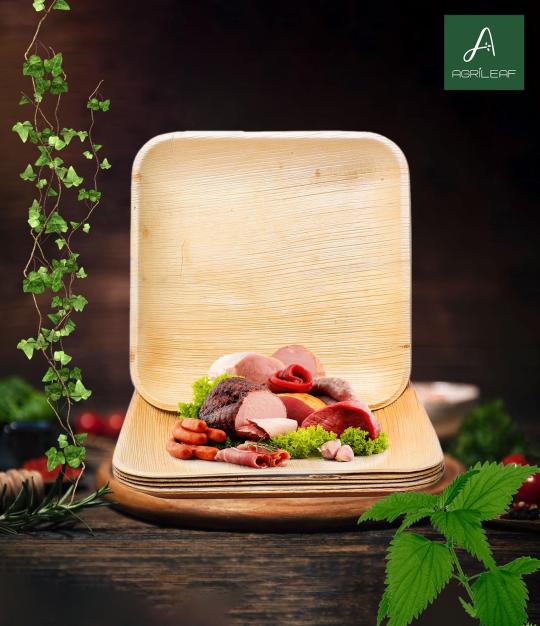
Some examples of eco-friendly dishes include those made from bamboo, palm leaf, sugarcane, and cornstarch. By choosing eco-friendly dishes, we can help reduce the amount of waste that ends up in landfills and minimize our carbon footprint.
Additionally, these dishes can be stylish and functional, making them a great option for any occasion, from picnics to dinner parties. Overall, incorporating eco-friendly dishes into our daily lives is a simple yet effective way to contribute to a more sustainable future. Agrileaf is also one the manufacturer of eco-friendly dishes.
To know more contact to the details given below:
Address : 2-63/A, Barangaya, Nidle Post, via Dharmasthala, Belthangady Taluk, Dakshina Kannada District – 574 216
Email : [email protected]
Phone number : +91 96060 23006
#biodegradable plates#eco friendly food plates#leaf disposable plates#green disposable plates#areca palm plates#leaf plate
2 notes
·
View notes
Photo

Kateel or Kateelu is a temple town in the Dakshina Kannada district of the Indian state of Karnataka. It is considered one of the holiest Hindu temple towns in India. It is situated on the banks of the river Nandini. #swiggywala #localguides #kateel #durgaparameshwari #temple #kateeltemple #kateelu #mangaluru #indiantemples #karnataka #tulunadu #porludatulunad https://www.instagram.com/p/CkLwG3Wv_xe/?igshid=NGJjMDIxMWI=
#swiggywala#localguides#kateel#durgaparameshwari#temple#kateeltemple#kateelu#mangaluru#indiantemples#karnataka#tulunadu#porludatulunad
4 notes
·
View notes
Text
ವಿಜಯಪುರ ಜಿಲ್ಲಾ ಆಸ್ಪತ್ರೆಯ ತಾಯಿ ಮತ್ತು ಮಕ್ಕಳ ಆಸ್ಪತ್ರೆಯಲ್ಲಿ ಬಾಣಂತಿಯರ ಪರದಾಟ, ಬಾಣಂತಿಯರ ಆಪರೇಷನ್ ಸ್ಟಿಚಸ್ ಬಿಚ್ಚಿ ರಕ್ತಸ್ರಾವದಿಂದ ನರಳಾಟ
ವಿಜಯಪುರ ಜಿಲ್ಲಾ ಆಸ್ಪತ್ರೆಯ ತಾಯಿ ಮತ್ತು ಮಕ್ಕಳ ಆಸ್ಪತ್ರೆಯಲ್ಲಿ ಬಾಣಂತಿಯರ ಪರದಾಟ, ಬಾಣಂತಿಯರ ಆಪರೇಷನ್ ಸ್ಟಿಚಸ್ ಬಿಚ್ಚಿ ರಕ್ತಸ್ರಾವದಿಂದ ನರಳಾಟ
ವಿಜಯಪುರ: ವಿಜಯಪುರ (Vijaypur) ಜಿಲ್ಲಾ ಆಸ್ಪತ್ರೆಯ ತಾಯಿ ಮತ್ತು ಮಕ್ಕಳ ಆಸ್ಪತ್ರೆಯಲ್ಲಿ ಬಾಣಂತಿಯರು ಪರದಾಡುತ್ತಿದ್ದಾರೆ. ಸಿಜೇರಿಯನ್ ಡೆಲಿವರಿ ಆದ ಬಾಣಂತಿಯರ ಆಪರೇಷನ್ (Operation) ಸ್ಟಿಚಸ್ ಬಿಚ್ಚಿ ರಕ್ತಸ್ರಾವದಿಂದ ನರಳಾಡುತ್ತಿದ್ದಾರೆ. ರಕ್ತಸ್ರಾವದಿಂದ ಡಿಸ್ವ್ಯಾರ್ಜ್ ಆಗಿ ಮನೆಗೆ ಹೋಗಿದ್ದ ಬಾಣಂತಿಯರು ವಾಪಸ್ ಮತ್ತೇ ಆಸ್ಪತ್ರೆಗೆ ದಾಖಲಾಗಿದ್ದಾರೆ. ಸ್ಡಿಚ್ಚಿಸ್ ಬಿಚ್ಚಿರೋ ಕಾರಣ ಮತ್ತೆ ಬಾಣಂತಿಯರು ಚಿಕಿತ್ಸೆಗೆ ಒಳಗಾಗುತ್ತಿದ್ದಾರೆ. ಇದಕ್ಕೆ ಆಸ್ಪತ್ರೆಯ ವೈದ್ಯರ ಹಾಗ��…
View On WordPress
#health#kannada news#karnataka latest news#Operation#Raichur rims hospital#Siddaramaiah#vijayapura district hospital#virat kohli
0 notes
Photo

A new freshwater crab species of the genus Vela Bahir & Yeo, 2007 (Decapoda: Brachyura: Gecarcinucidae) from the Western Ghats of Karnataka, India
SAMEER KUMAR PATI, PARASHURAM PRABHU BAJANTRI, GOPALKRISHNA DATTATRAYA HEGDE
Abstract
Vela bandhavya sp. nov., a new species of gecarcinucid crab is described from the Central Western Ghats, Uttara Kannada district, Karnataka state, India.
The new species can be immediately distinguished from three other species of Vela Bahir & Yeo, 2007, mainly by its short male sternopleonal cavity and a relatively shorter distal article of the male first gonopod.
The diagnosis of Vela is revised to accommodate the new species, and an illustrated identification key is provided for all four species. An anomalous adult male crab, with a pair of pleopods on the pleonal somite 5 in addition to the male gonopods, is also reported.
Read the paper here:
https://mapress.com/zt/article/view/zootaxa.5239.1.5
54 notes
·
View notes